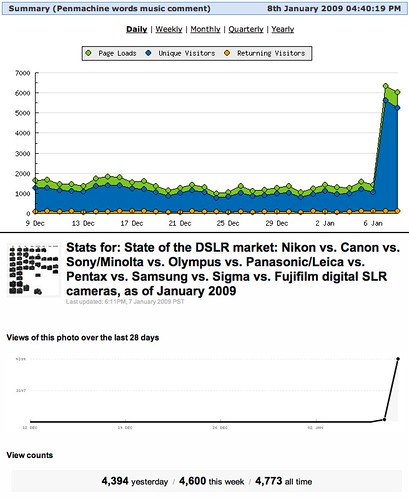Penmachine
07 January 2009
Are there perhaps too many digital SLRs on the market?
One way to get lots of people to see a photo of yours on the image sharing site Flickr is to take a good picture. That requires talent, skill, and dedication. A few of my pictures have become popular simply because they're good photographs—at least I think so.
But my most popular pictures on Flickr aren't like that at all. They're nerdy: pictures of wacky guitars or geek conferences, of old computers or Linux running on a Mac.
And what do you do to attract huge numbers of viewers and comments and favourites? Simple, go full nerd: just make a picture of a whole bunch of cameras and encourage people to argue about them. More than 38,000 views in six months, 208 favourite votes, and dozens and dozens of comments:
Old image of almost 25 cameras
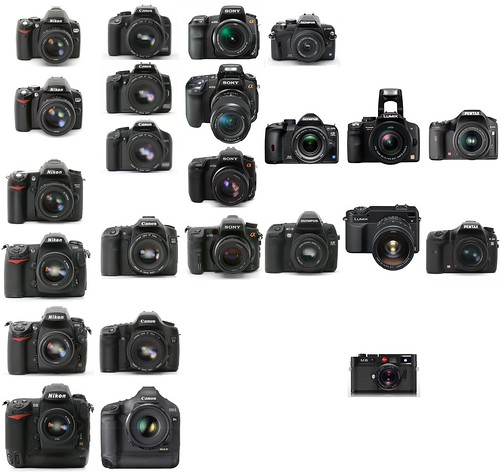
State of the DSLR market - June 2008 (old)
An earlier attempt of mine at the same thing even had commenters threatening to kill each other about the kind of camera they like! But my favourite comment was from Axl Van Goks: "I like the black one with the buttons and stuff."
Since the digital camera market changes like crazy, my big collage from June 2008 was out of date within weeks. I waited for all the pre-Christmas camera introductions to shake out, and now I've made a new version that includes all the current digital SLR cameras I could find (almost 40) from Nikon, Canon, Sony, Olympus, Pentax, Panasonic, Leica, Samsung, Sigma, and Fujifilm:
New image of almost 40 cameras
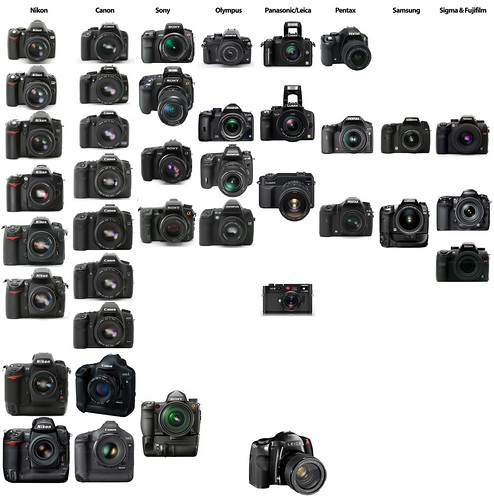
State of the DSLR market - January 2009 (new)
I expect the arguing to begin soon in the comments. The picture has 139 views and 4 favourites since I posted it three and a half hours ago. And yes, yes, I know, I know: they're not all strictly SLRs, but I think they're all of interest to SLR buyers.
Ah, art. Have at it.
UPDATE: My thesis appears to be correct. As a rule of thumb, the more cameras you put in a picture on Flickr, the more popular it is:
Links from John Gruber and 37signals didn't hurt either.
Labels: canon, controversy, flickr, geekery, leica, linkbait, nikon, olympus, panasonic, pentax, photography, sony
28 December 2008
Wasted megapixels
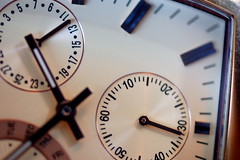 I like what the team at Digital Photography Review have to say about the world of digital SLR cameras (my emphasis below):
I like what the team at Digital Photography Review have to say about the world of digital SLR cameras (my emphasis below):
...the biggest issue facing manufacturers today [is that] ever-increasing sensor resolutions are simply not being backed up by lenses capable of delivering enough detail, [so what are] all those extra megapixels [...] supposed to achieve (other than take up storage space and slow the camera down). [...] we'd rather see manufacturers directing their R&D resources towards improving sensor efficiency, to give reduced noise and increased dynamic range, rather than continuing the megapixel marketing mania.
What Andy Westlake is saying is that, especially for the crop-sensor DSLR cameras most people buy, even the best lenses that Nikon, Canon, Zeiss, Leica, and others make don't provide enough resolution to take full advantage of all the megapixels packed onto the sensors in the cameras they connect to. Certainly the inexpensive lenses that most DSLRs come with don't do that.
For a long time, I used my 2006-era Nikon D50, which has "only" a 6-megapixel sensor, in reduced-resolution mode, taking pictures that were a bit over 3 megapixels. They were big and detailed enough for me as an amateur photo enthusiast, but I eventually moved up to the full 6 MP resolution when I got a bigger hard drive and didn't mind the extra room that larger files sucked up. So while I lust after the improved low-light performance and faster burst modes of newer cameras like the D90 and D300, their increased resolution on the same size sensor actually turns me off a bit, because of the extra storage I'll need for the images. (They do have reduced-resolution 6.9 MP and 3 MP modes, however.)
It is true that a 12-megapixel crop-sensor DSLR still gives you a significant real resolution advantage—when using quality lenses. But pushing up to 15 MP and beyond, as crop-sensor DSLRs are starting to do, seems to be going further than what our lenses are capable of. (As DPReview notes, that won't happen for full-frame DSLRs until they get into the 38-megapixel range, which I expect in the next couple of years.) In the point-and-shoot market, with even smaller sensors and smaller, lower-quality lenses, the problem is worse.
Until recently, Nikon has generally resisted the more-more-more megapixels bandwagon with their DSLRs—more so than Canon, Sony, and others—and emphasized performance instead. But I wish all of them would look at the example of Panasonic's recent DMC-LX3 point-and-shoot: "Other cameras offer more pixels, more zoom, and bigger LCDs," says review Jeff Keller, "[but it] does deliver very good quality images for a compact camera."
That's what we photographers really want, isn't it? Good pictures? Especially if we're paying for megapixels that out-resolve our lenses, and are therefore largely going to waste!
Labels: controversy, geekery, nikon, panasonic, photography
03 July 2008
State of the digital SLR market: Nikon, Canon, Sony, Olympus, Panasonic, Pentax, and Leica
Last year I created a little composite image of the various interchangeable-lens digital single-lens reflex (DSLR) cameras then available from Nikon and Canon, the two leading camera manufacturers. It turned out to be one of my most popular pictures at the Flickr photo sharing service, of course because photo enthusiasts like to argue about Canon vs. Nikon almost as much as Mac and PC people do about their computers.
It became out of date pretty fast, with models discontinued and new ones introduced. But people kept looking at the image and commenting. So I decided to go further and create a similar composite visual chart of DSLRs currently available, as of the end of June 2008, from all the major camera makers: Nikon, Canon, Sony/Minolta, Olympus, Panasonic/Leica, and Pentax. The pictures are all the companies' publicity photos, sometimes sourced directly from their websites, sometimes from others such as DP Review and DC Resource:
No wonder people are confused about which camera to buy! Prices here range from around $500 (with lens) to about $8000 (no lens). The smallest cameras in this bunch are the Leica M8 (off by itself on the lower right, and not an SLR, see below) and the Olympus E-420 (top of the fourth column, see this review for real-life size comparison photos). The heaviest are the two pro monsters, the Nikon D3 and Canon 1Ds Mark III, in the lower left.
I have excluded a few other makers, such as Fuji and Sigma, and rebadged models from Samsung (nearly the same as some Pentaxes) and Leica (almost identical to the Panasonics). These images reflect the main line of SLRs (plus the M8) as of this writing.
Relative camera sizes are not exact. The positions of the various models vaguely reflect my impressions of a combination of price, features, and market segment. That's quite subjective, so you could easily argue with my placement of some of them. Take the image as a general guideline. Look down the columns to see how different cameras from a single manufacturer compare from low-end to high-end; look across the rows to see roughly comparable cameras (in features, price, or both) from different makers that compete with one another.
Nikon and Canon are (currently) alone in providing full-frame size semi-pro and professional DSLRs: the D700, EOS 5D, D3, and EOS 1Ds Mark III. The Leica M8 is the real outlier—not an SLR at all, but a digital version of the classic Leica M rangefinder; I put it here because a significant number of photographers looking at the high-end Nikons and Canons might also consider it.
The most crowded market segments are the introductory level (with something, and sometimes several confusing models, from every manufacturer), and the midrange enthusiast section (with some interesting choices like the D80, D300, 40D, A700, E-3, DMC-L1, and K20D). With all the choices, this might be the most interesting time in the history of single-lens reflex cameras, certainly in the digital era.
I also left out some models. Canon's pro sports-focused 1D Mark III, which looks and works essentially identically to the 1Ds Mark III, is one—the difference is that the "s" indicates a larger full-frame sensor (Canon needs a serious simplification of its naming scheme). The Nikon D40 is also the same body as the D40x (and the D60), but with a lower-resolution sensor. Some of these models, such as the D40x and the Canon XTi, may be theoretically discontinued now or soon, but remain widely available.
Finally, there will probably soon be updates rendering this composite chart at least partially obsolete. Canon is expected to replace the three-year-old EOS 5D any old time, Nikon might do the same for the similarly aged D80, Sony may release a full-frame DSLR (since they make Nikon's full-frame sensor, I believe), and Nikon could bring out a D3x or similar model with a higher-resolution full-frame sensor like the 1Ds Mark III. I'll let you know.
Labels: canon, gadgets, geekery, leica, nikon, olympus, panasonic, pentax, photography, sony
01 April 2008
Camcorders have changed in 10 years
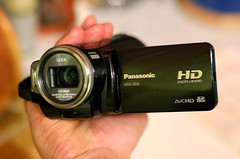 Over at Inside Home Recording, we recently started IHR TV, additional short video tutorials that augment our regular longer audio podcasts. As part of that effort, we used some of the money we get from sponsors and advertisers to buy two Panasonic HDC-SD5 high-definition camcorders. (Bought online, two of them cost only very slightly more than a single one at local retail stores.)
Over at Inside Home Recording, we recently started IHR TV, additional short video tutorials that augment our regular longer audio podcasts. As part of that effort, we used some of the money we get from sponsors and advertisers to buy two Panasonic HDC-SD5 high-definition camcorders. (Bought online, two of them cost only very slightly more than a single one at local retail stores.)
The last camcorder my family had, which sits half-broken in our basement, was an old Samsung analogue Video 8 tape-based machine, from 1998. Given the improvements in other consumer electronics, from personal computers to digital cameras to televisions, over the past decade, I'm not sure why I'm so surprised at this little camcorder, but it's a remarkable machine.
Consider, first, that it can record at 1920x1080i "Full HD" resolution, with something like six times the detail of our old camera, using a very nice mechanically stabilized Leica lens. It stores that information not on tapes, but on the same SD cards used by the still cameras and audio recorders we have at the house. The whole camera is only about a third larger, and almost exactly the same weight, as the old Samsung battery—being smaller than my hand, it almost gets lost among its accessories in our camcorder bag.
Perhaps most remarkably, Panasonic has put real thought into simplifying how the camera works. There aren't many buttons and dials, they're clearly labeled, and everything is easy enough to figure out that the manual (which is long and detailed, but only averagely written) is only necessary for some of the more detailed settings. The SD5 even takes pretty nice still photos.
Those huge HD videos, however, require a lot of horsepower to edit: only one of the computers in our house (my Intel MacBook) will even import the massive AVCHD video files directly. And, following the trend in pocket still cameras, there is no longer a viewfinder: you have to look at the pop-out LCD screen to frame your shots. Like too many consumer electronics today, the camera also comes festooned with garish and difficult-to-remove little stickers advertising its features, the software it comes with, and so on. I removed those immediately.
It lacks a couple of pro features that would be useful: the only sound-in is from the stereo microphone, so you can't connect an external mic or line-in sound, which is something I'll work around with a separate audio recorder if needed. (Very cleverly, though, the microphones can focus in on your subject as you zoom the lens, and electronically filter out some wind noise. Nifty.) Similarly, while it comes with cables to send sound and video out to a TV or other device, you can't record video from any source other than the lens, so I can't, for instance, use it to digitize any of our old footage.
With devices like these, it's no wonder people can now smuggle broadcast-quality video out of the world's war zones and trouble spots. We'll see what I can do with this camera and my mediocre video skills for our modest little podcast.
Labels: geekery, leica, panasonic, photography, podcast, video
